Effects of Recent Climate Change on Hourly Weather Data for HVAC Design: A Case Study of Osaka
Abstract
:1. Introduction
1.1. Climate Change and Urban Heat Islands
1.2. Building Energy Savings and Design Weather Data
1.3. Aims of this Study
2. Analysis of Change in External Weather Data
3. New Design Hourly Weather Data
3.1. Creation Method
3.2. Comparison with the Old Design Hourly Weather Data
- ▪
- Comparing the new and old hourly dry-bulb temperature, some of the most apparent differences include: (i) the new design hourly weather data using the mean daily dry-bulb temperature as the first and second indices (M2-a in Figure 3a), yields an average of 0.7 °C lower temperature during the time period from 1:00 to 9:00 in the morning (i.e., the cooler winter days are trending towards having cooler nights and early mornings); (ii) the new design hourly weather data in all four methods using the mean daily dry-bulb temperature as the first index (M1-a, M2-a, M3-a, M4-a in Figure 3a), yields an average of 0.8 °C higher temperature during the time period from 15:00 to 24:00 in the afternoon (i.e., the cooler winter days trending towards having warmer evenings); (iii) the new design hourly weather data using the mean daily enthalpy as the first index and the mean daily accumulative horizontal global solar radiation as the second index (M4-b in Figure 4a), yields an average of 2.0 °C higher temperature during the time period from 1:00 to 9:00 in the morning (i.e., the lower enthalpy winter days on which there was less sunshine are trending towards having much warmer nights and early mornings, as clouds likely reduce radiant cooling); (iv) the new design hourly weather data using the mean daily enthalpy both as the first and second indices (M1-b, M2-b in Figure 4a), yields an average of 1.0 °C lower temperature throughout the day (i.e., the lower enthalpy winter days without considering sunshine or temperature are trending towards being cooler).
- ▪
- Comparing the new and old hourly absolute humidity: (i) the new design hourly weather data using the mean daily dry-bulb temperature as the first index and the mean daily accumulative horizontal global solar radiation as the second index (M4-a in Figure 3a), yields an average of 0.7 g/kg higher humidity throughout the day (i.e., the cooler winter days with less sunshine are trending towards being more humid); (ii) the new design hourly weather data using the mean daily enthalpy as the first index (M1-b, M2-b, M3-b, M4-b in Figure 4a), showed no significant change.
- ▪
- Comparing the new and old hourly enthalpy: (i) the new design hourly weather data using the mean daily dry-bulb temperature as the first index and the mean daily accumulative horizontal global solar radiation as the second index (M4-a in Figure 3a), yields an average of 1.3 J/g higher enthalpy throughout the day (i.e., the cooler winter days with less sunshine are trending towards having higher enthalpy); (ii) the new design hourly weather data using the mean daily enthalpy as the first index and the mean daily accumulative horizontal global solar radiation as the second index (M4-b in Figure 4a), yields an average of 2.0 J/g higher enthalpy during the time period from 1:00 to 9:00 in the morning (i.e., the winter days of lower enthalpy and less sunshine are trending towards having much higher enthalpy in the nights and early mornings); (iii) the new design hourly weather data using the mean daily enthalpy as the first and second indices (M1-b, M2-b in Figure 4a), yields an average of 2.0 J/g lower enthalpy throughout the day (i.e., the winter days of lower enthalpy without considering sunshine or temperature are trending towards having much lower enthalpy).
- ▪
- Comparing the new and old hourly horizontal global solar radiation: (i) the new design hourly weather data using the mean daily dry-bulb temperature as the first index and the mean daily enthalpy as the second index (M3-a in Figure 3a), yields an average of about 30 W/m2 higher global solar radiation at the daily peak value (i.e., the daily peak sunshine is trending towards being higher on the cooler, low enthalpy winter days); (ii) the new design hourly weather data using the mean daily enthalpy as the first index and the mean daily accumulative horizontal global solar radiation as the second index (M4-b in Figure 4a), yields an average of about 70 W/m2 lower global solar radiation at the daily peak value (i.e., the daily peak sunshine is trending towards being much lower on the low enthalpy, low sunshine winter days).
- ▪
- Comparing the new and old hourly dry-bulb temperature: (i) the new design hourly weather data using the mean daily dry-bulb temperature as the first index (M1-a, M2-a, M3-a, M4-a in Figure 3b), yields an average of about 0.8 °C higher temperature throughout the day (i.e., the hotter summer days without considering sunshine or enthalpy are trending towards being much hotter); (ii) the new design hourly weather data using the mean daily enthalpy as the first index (M1-b, M2-b, M3-b, M4-b in Figure 4b), yields an average of about 2.0 °C higher temperature throughout the day (i.e., the higher enthalpy summer days without considering sunshine or temperature are trending towards being much hotter).
- ▪
- Comparing the new and old hourly absolute humidity: (i) the new design hourly weather data using the mean daily dry-bulb temperature as the first index and the mean daily accumulative horizontal global solar radiation as the second index (M4-a in Figure 3b), yields an average of about 2.0 g/kg lower humidity throughout the day (i.e., the hotter summer days with greater sunshine are trending towards being less humid); (ii) the new design hourly weather data using the mean daily enthalpy as the first index (M1-b, M2-b, M3-b, M4-b in Figure 4b), has no significant change.
- ▪
- Comparing the new and old hourly enthalpy: (i) the new design hourly weather data using the mean daily dry-bulb temperature as the first index (M1-a, M2-a, M3-a, M4-a in Figure 3b), yields an average of about 5.0 J/g lower enthalpy throughout the day (i.e., the hotter summer days without considering sunshine or enthalpy are trending towards having much lower enthalpy); (ii) the new design hourly weather data using the mean daily enthalpy as the first index (M1-b, M2-b, M3-b, M4-b in Figure 4b), yields an average of about 3.0 J/g lower enthalpy throughout the day (i.e., the higher enthalpy summer days without considering sunshine or temperature are trending towards having much lower enthalpy).
- ▪
- Comparing the new and old hourly horizontal global solar radiation: (i) the new design hourly weather data using the mean daily dry-bulb temperature as the first index (M1-a, M2-a, M3-a, M4-a in Figure 3b), yields an average of about 100 W/m2 higher global solar radiation at the daily peak value (i.e., the daily peak sunshine is trending towards being much higher on the hot summer days); (ii) the new design hourly weather data using the mean daily enthalpy as the first index (M1-b, M2-b, M3-b, M4-b in Figure 4b), yields an average of about 120 W/m2 higher global solar radiation at the daily peak value (i.e., the daily peak sunshine is trending towards being much higher on the high enthalpy summer days).
- ▪
- The variance among design hourly weather data with various methods for each weather element for heating design tends to be larger than that for cooling design.
- ▪
- The greater the standard deviation, the greater the difference among the design hourly weather data using the various methods. For example, the enthalpy showed much more variation in the old design weather data set for the heating period.
4. Calculation of Peak Thermal Loads Using Design Data
4.1. Simulation
4.2. Outdoor Air Load Calculation
4.3. Results and Discussion
5. Conclusions and Future Research
Author Contributions
Conflicts of Interest
Appendix A
| Data Source: EA data for Osaka, Japan of 15 years (2001–2015) Heating Period: December-March; Cooling Period: June-September | |
|---|---|
| The First Index | Methods (the Second Index) |
| ▪ First index: Mean daily dry-bulb temperature of 15 years (1830 days for summer period; 1818 days for winter period) ▪ Selected day: The 19 days with frequency of occurrence between the top 2% to 3% were selected by ranking the value of the first index | M1-a: The 19 days with frequency of occurrence between 2% to 3% for heating(h*) and between 97% to 98% for cooling(c*) were selected by ranking the value of the first index M2-a: Three days with the lowest h* and highest c* mean daily dry-bulb temperature are selected from the 19 days of the first index M3-a: Three days with the lowest h* and highest c* mean daily enthalpy selected from the 19 days of the first index M4-a: Three days with the lowest h* and highest c* mean daily cumulative horizontal global solar radiation are selected from the 19 days of the first index |
| ▪ First index: Mean daily enthalpy of 15 years (1830 days for summer period; 1818 days for winter period) ▪ Selected day: The 19 days with frequency of occurrence between the top 2% to 3% were selected by ranking the value of the first index | M1-b: The 19 days with frequency of occurrence between the top 2% to 3% h* and between 97% to 98%c* were selected by ranking the value of the first index M2-b: Three days with the lowest h* and highest c* mean daily enthalpy are selected from the 19 days of the first index M3-b: Three days with the lowest h* and highest c* mean daily dry-bulb temperature are selected from the 19 days of the first index M4-b: Three days with the lowest h* and highest c* mean daily cumulative horizontal global solar radiation are selected from the 19 days of the first index |
References
- Loeb, N.G.; Lyman, J.M.; Johnson, G.C.; Allan, R.P.; Doelling, D.R.; Wong, T.; Soden, B.J.; Stephens, G.L. Observed changes in top-of-the-atmosphere radiation and upper-ocean heating consistent within uncertainty. Nat. Geosci. 2012, 5, 110–113. [Google Scholar] [CrossRef]
- Stephens, G.L.; Li, J.; Wild, M.; Clayson, C.A.; Loeb, N.; Kato, S.; L’Ecuyer, S.; Stackhouse, P.E., Jr.; Lebsock, M.; Andrews, T. An update on Earth’s energy balance in light of the latest global observations. Nat. Geosci. 2012, 5, 691–696. [Google Scholar] [CrossRef]
- National Science and Technology Council, the U.S. Climate Change Science Program (CCSP). Effects of Climate Change on Energy Production and Use in the United States. Part of a Series of Synthesis and Assessment Products Produced by the CCSP; January 2008. Available online: https://science.energy.gov/~/media/ber/pdf/Sap_4_5_final_all.pdf (accessed on 15 June 2017).
- Pérez-Lombard, L.; Ortiz, J.; Pout, C. A review on buildings energy consumption information. Energy Build. 2008, 40, 394–398. [Google Scholar] [CrossRef]
- Agency for Natural Resources and Energy. Energy in Japan. 2013. Available online: http://www.enecho.meti.go.jp/en/ (accessed on 17 June 2017).
- The Society of Heating, Air-conditioning and Sanitary Engineers (SHASE). Handbook of Heating, AC and Sanitary; Version 13; SHASE: Tokyo, Japan, 2016; Volume 3. (In Japanese) [Google Scholar]
- Takeda, H. Tokyo weather data for air-conditioning: Part 1-outdoor design conditions for heating and cooling loads by T.A.C. method. Trans. Soc. Heat. Air-Cond. Sanit. Eng. Japan 1989, 41, 105–115. (In Japanese) [Google Scholar] [CrossRef]
- Takizawa, H. Micro-peak program. In SHASE Symposium ‘Thermal Load and Software’; SHASE: Tokyo, Japan, 1989; pp. 13–24. (In Japanese) [Google Scholar]
- Okuda, Y.; Ikezawa, H. Simulation analysis of outdoor conditions for heating design. Trans. Soc. Heat. Air-Cond. Sanit. Eng. Japan 1978, 8, 11–22. (In Japanese) [Google Scholar]
- Colliver, D.G.; Gates, R.S.; Zhang, H.; Priddy, K.T. Sequences of extreme temperature and humidity for design calculations. ASHRAE Trans. 1998, 104, 133. [Google Scholar]
- Ishino, H. Proposal of Seven-Day Design Weather Data for HVAC Peak Load Calculation. In Proceedings of the 9th International Building Performance Simulation Association Conference, Montreal, QC, Canada, 15–18 August 2005; pp. 451–458. [Google Scholar]
- Wang, L.; Liu, X.; Brown, H. Prediction of the impacts of climate change on energy consumption for a medium-size office building with two climate models. Energy Build. 2017, 157, 218–226. [Google Scholar] [CrossRef]
- Nik, V.M. Application of typical and extreme weather data sets in the hygrothermal simulation of building components for future climate—A case study for a wooden frame wall. Energy Build. 2017, 154, 30–45. [Google Scholar] [CrossRef]
- Pyrgou, A.; Castaldo, V.L.; Pisello, A.L.; Cotana, F.; Santamouris, M. Differentiating responses of weather files and local climate change to explain variations in building thermal-energy performance simulations. Solar Energy 2017, 153, 224–237. [Google Scholar] [CrossRef]
- Pernigotto, G.; Prada, A.; Cappelletti, F.; Gasparella, A. Influence of the Representativeness of Reference Weather Data in Multi-objective Optimization of Building Refurbishment. In Proceedings of the 14th International Conference of the International Building Performance Simulation Association, Hyderabad, India, 7–9 December 2015; pp. 2857–2864. [Google Scholar]
- Yuan, J.; Emura, K.; Farnham, C.; Lu, S.; He, C. The creation of weather data for AC design using two weather indices for Osaka. Energy Build. 2017, 134, 248–258. [Google Scholar] [CrossRef]
- Japan Weather Agency. Expanded AMeDAS Weather Data. 2013. Available online: http://www.jma.go.jp/amedas/ (accessed on 17 June 2017).
- The Society of Heating, Air-Conditioning and Sanitary Engineers of Japan (SHASEJ). HASPEE_1.0.3. Manual. 2013. Available online: http://www.shasej.org/ (accessed on 13 September 2016).
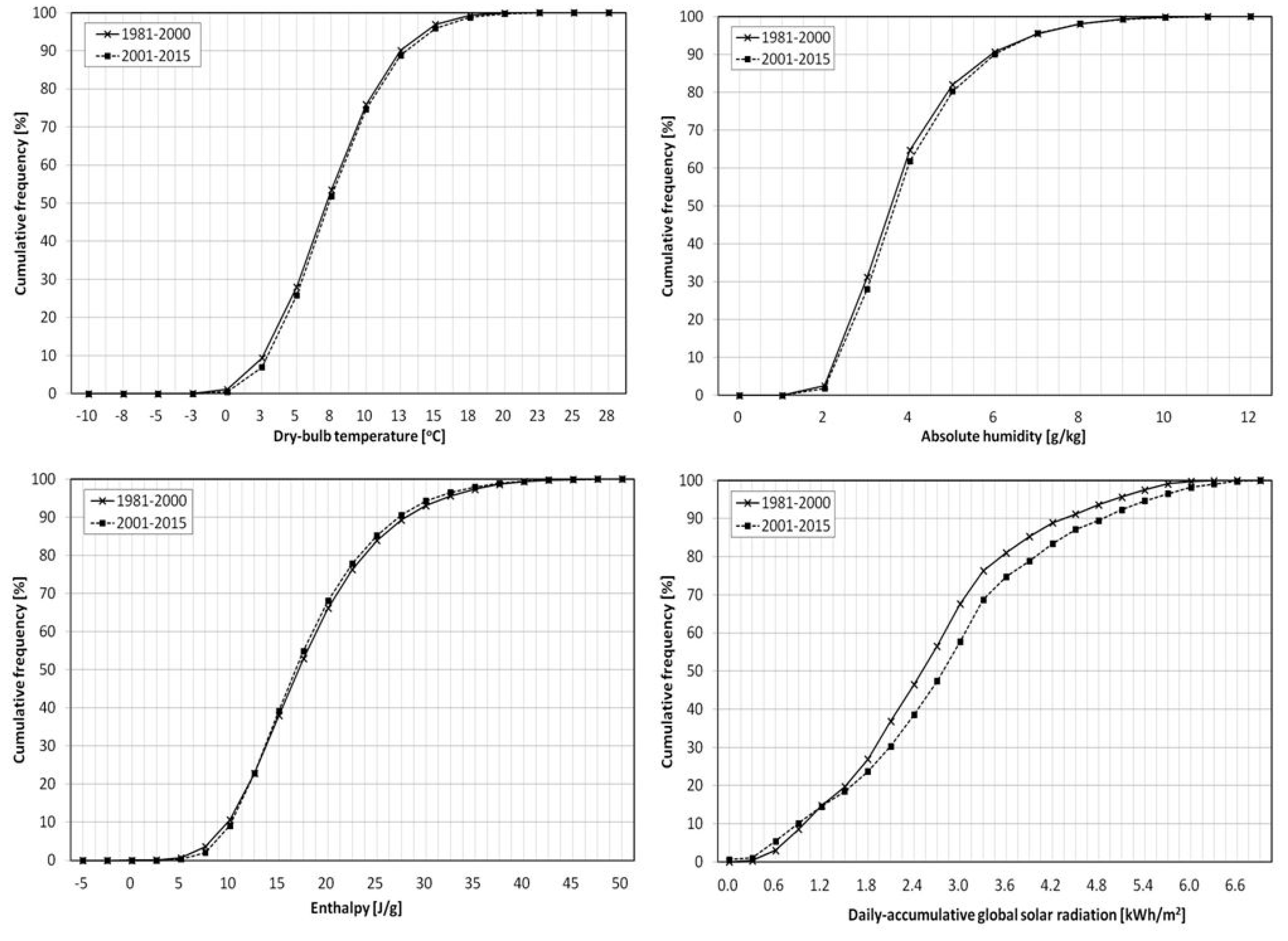
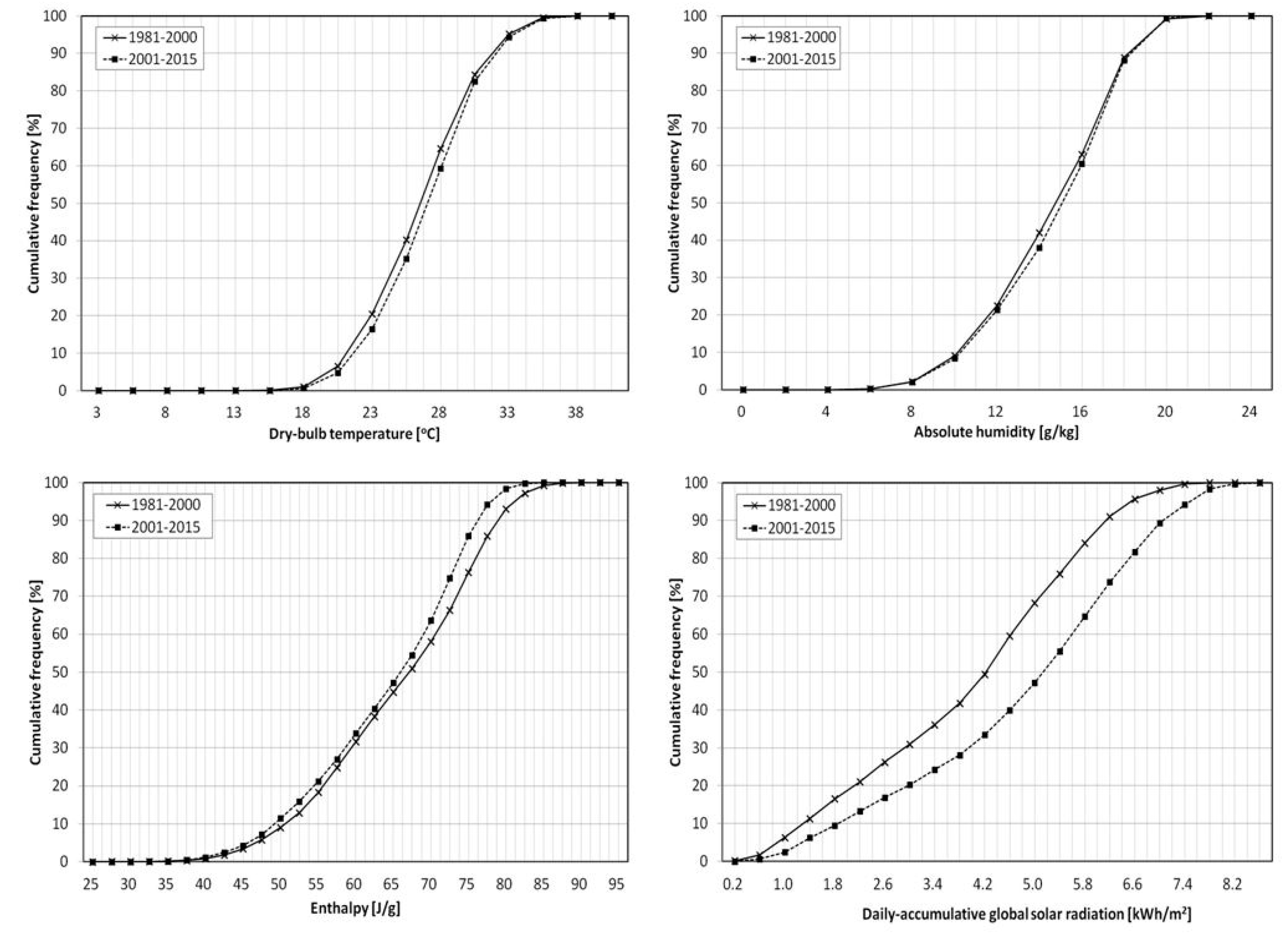
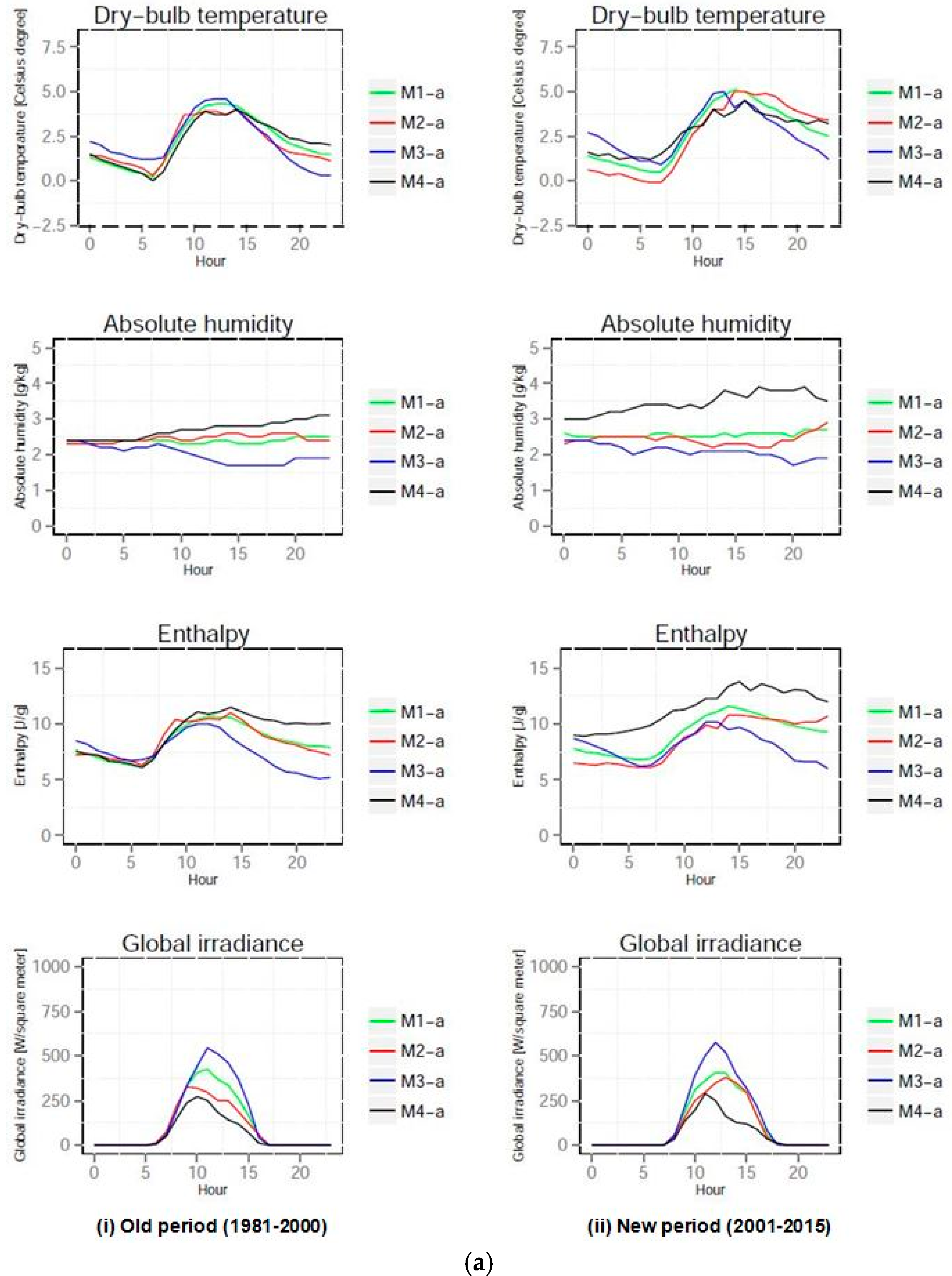
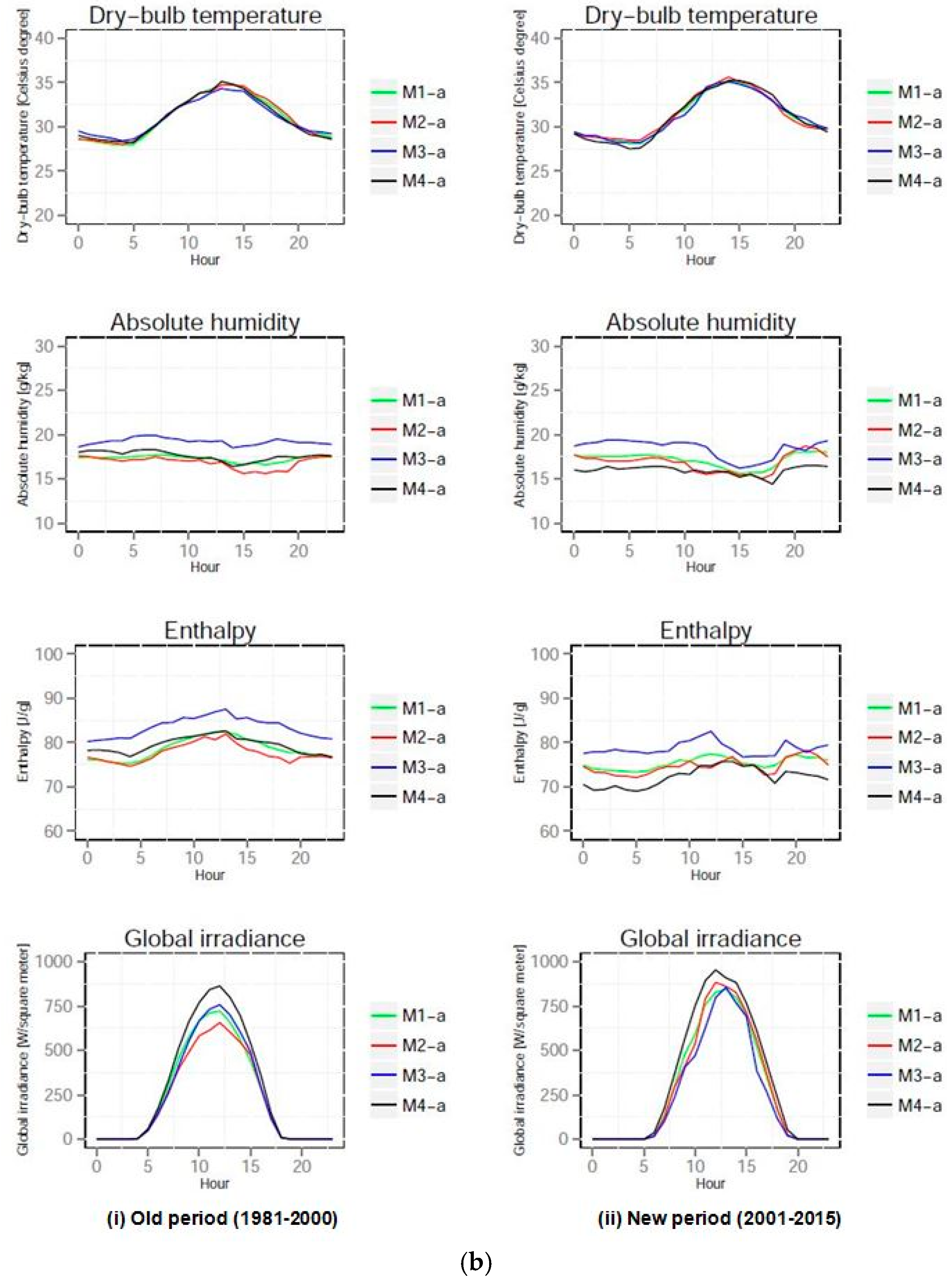

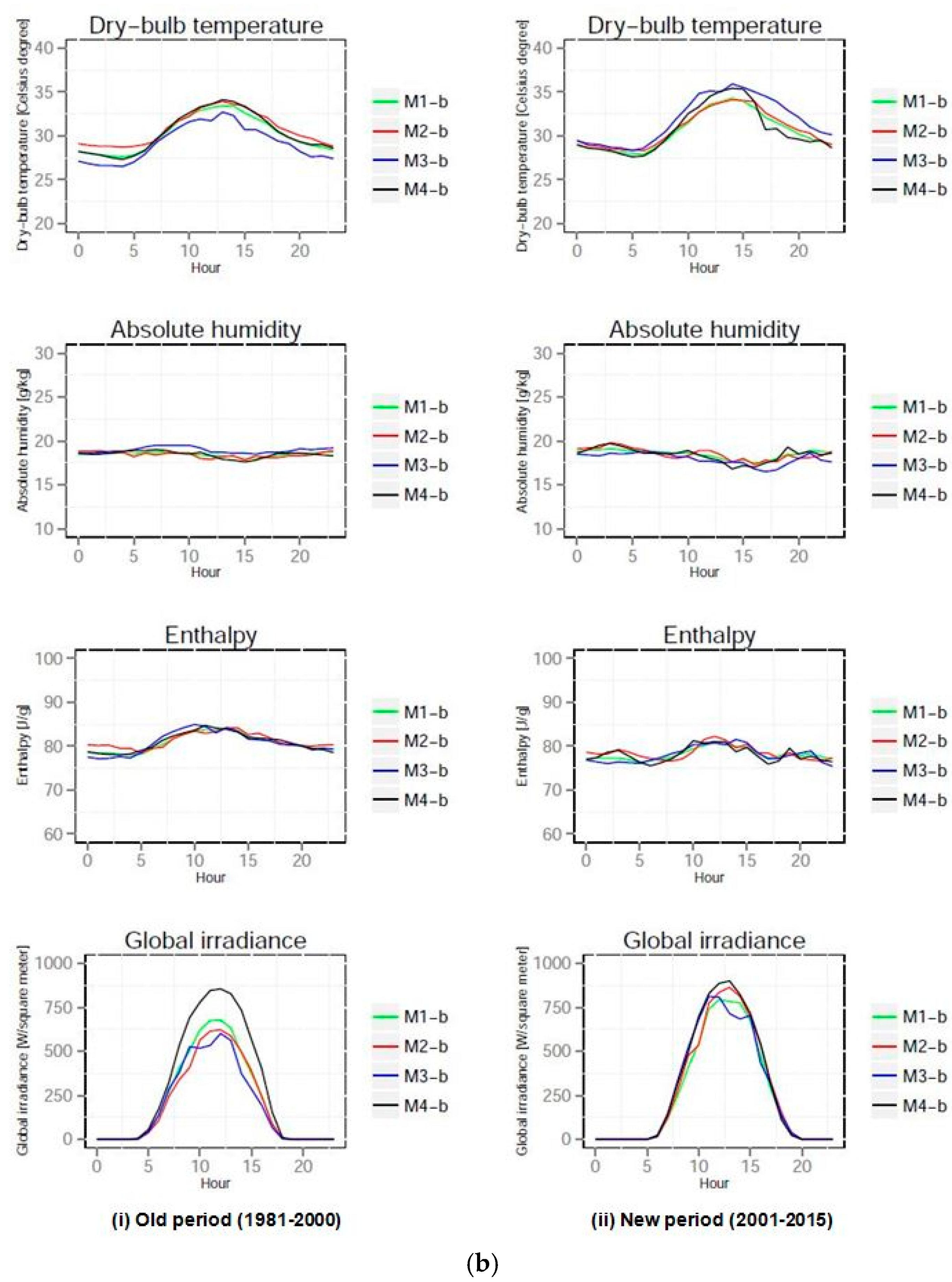
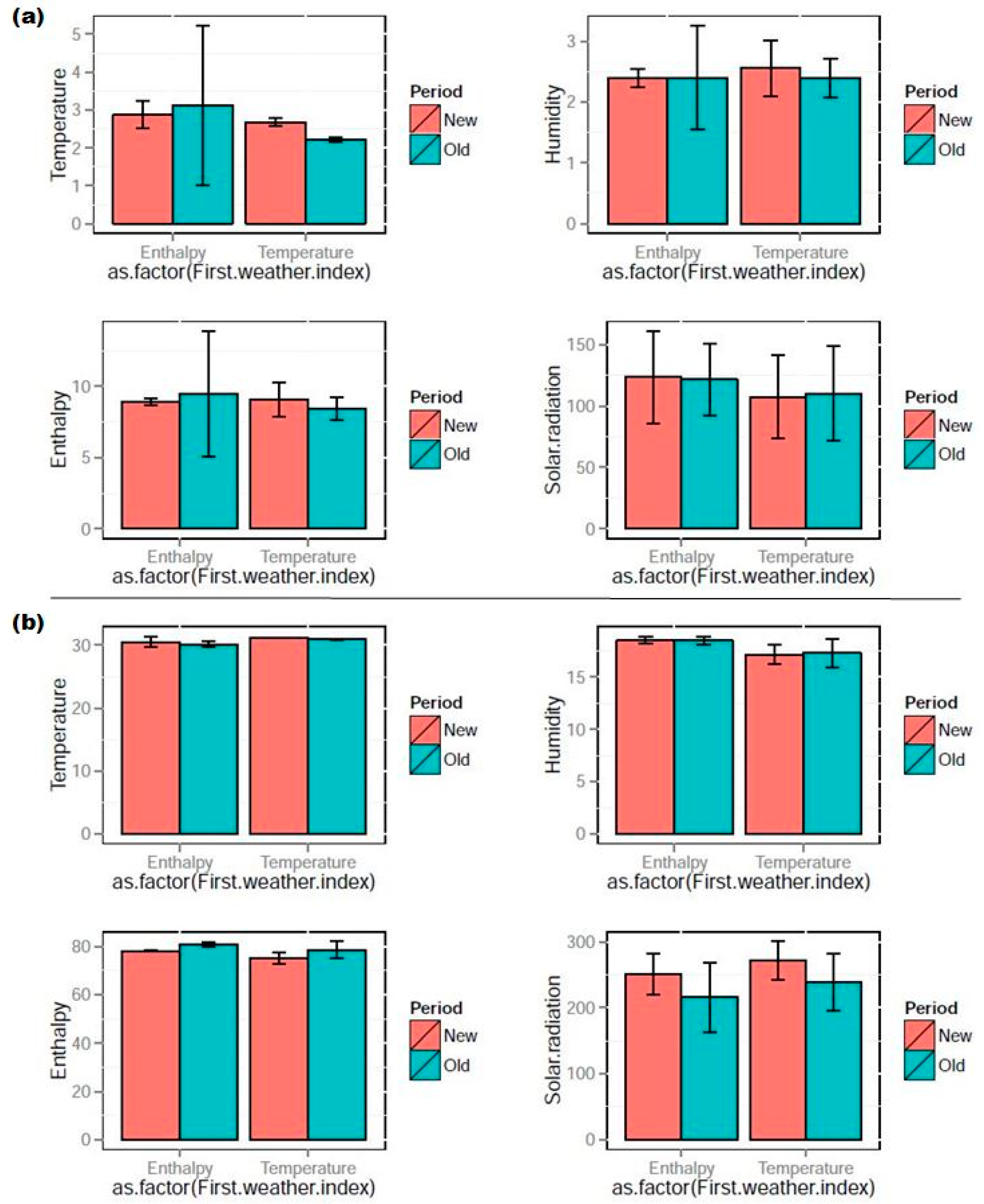

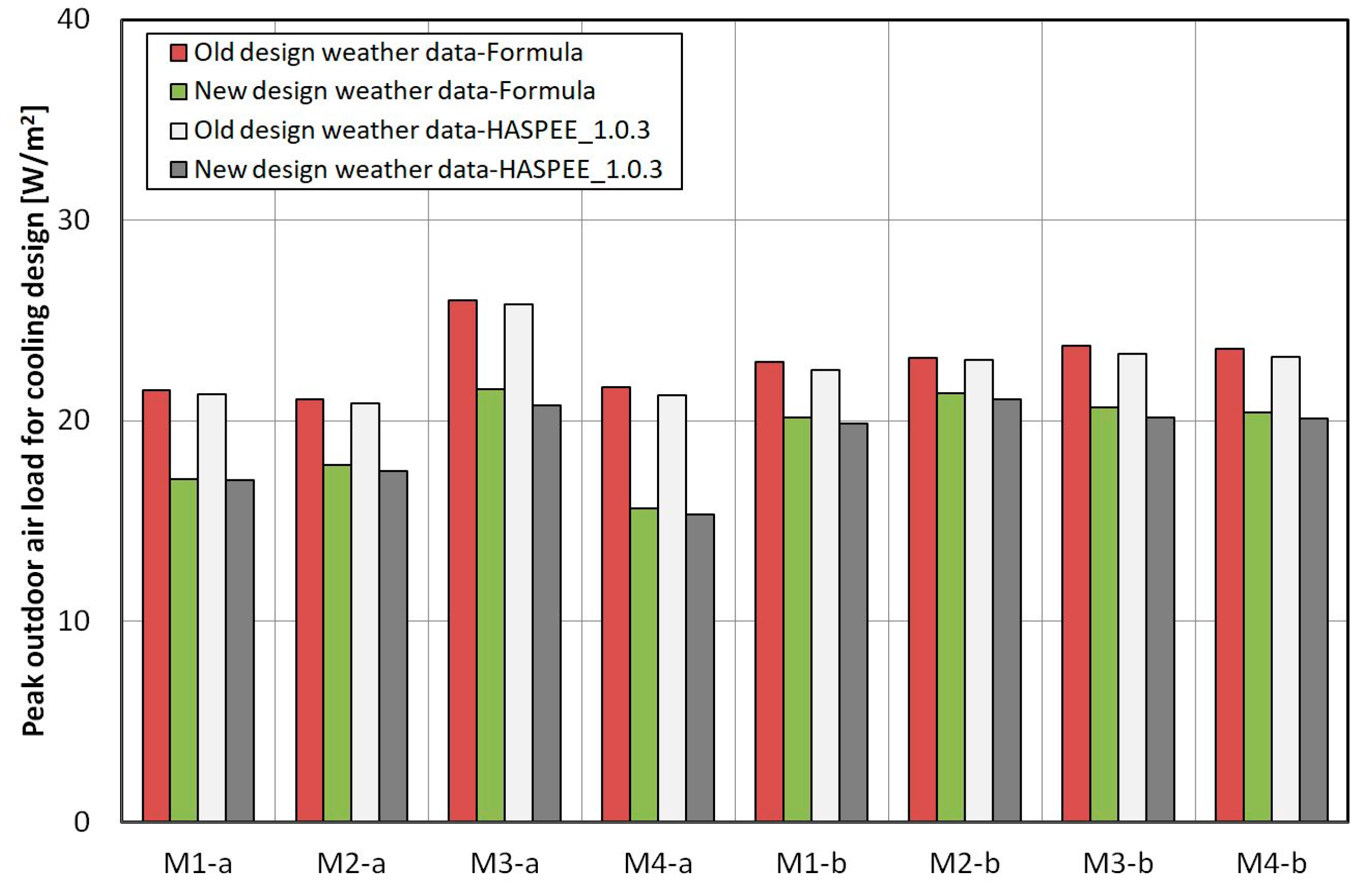
| Simulated building information: •East–West Road (South and North-facing wall) •Air-conditioned area of the mid-level floor (A): 605 m2 •Floor height (Hf)/Ceiling height (Hc): 3.6 m/2.6 m •Building exterior wall structure (in order from indoor to outdoor): Wood (0.02 m) + Insulation (0.03 m) + Air layer (0.02 m) + Heavy concrete blocks (0.15 m) + Cement mortar (0.02 m) + Tile (0.008 m) |
| Dry-bulb temperature, relative humidity and enthalpy settings: •26 °C, 60% and 58 kJ/kg in summer period from June to September •22 °C, 40% and 39 kJ/kg in winter period from December to March •24 °C, 50% and 48 kJ/kg in middle period from April to May, October to November |
| Heating and Cooling hours: •From 8:00 to 18:00 (Warming-up hours in winter: 8:00-9:00; Cooling-down hours in summer: 8:00–9:00) |
| Internal heat generation: •Occupants: 0.2 person/m2 •Lighting: 20 W/m2 •OA equipment: 24 W/m2 |
| Ventilation: •Ventilation frequency of fresh air (n): 0.8/h •Amount of fresh air (Afa): Afa = n × A × Hc •Ventilation hours: 9:00-18:00 |
© 2018 by the authors. Licensee MDPI, Basel, Switzerland. This article is an open access article distributed under the terms and conditions of the Creative Commons Attribution (CC BY) license (http://creativecommons.org/licenses/by/4.0/).
Share and Cite
Yuan, J.; Emura, K.; Farnham, C. Effects of Recent Climate Change on Hourly Weather Data for HVAC Design: A Case Study of Osaka. Sustainability 2018, 10, 861. https://doi.org/10.3390/su10030861
Yuan J, Emura K, Farnham C. Effects of Recent Climate Change on Hourly Weather Data for HVAC Design: A Case Study of Osaka. Sustainability. 2018; 10(3):861. https://doi.org/10.3390/su10030861
Chicago/Turabian StyleYuan, Jihui, Kazuo Emura, and Craig Farnham. 2018. "Effects of Recent Climate Change on Hourly Weather Data for HVAC Design: A Case Study of Osaka" Sustainability 10, no. 3: 861. https://doi.org/10.3390/su10030861
APA StyleYuan, J., Emura, K., & Farnham, C. (2018). Effects of Recent Climate Change on Hourly Weather Data for HVAC Design: A Case Study of Osaka. Sustainability, 10(3), 861. https://doi.org/10.3390/su10030861







